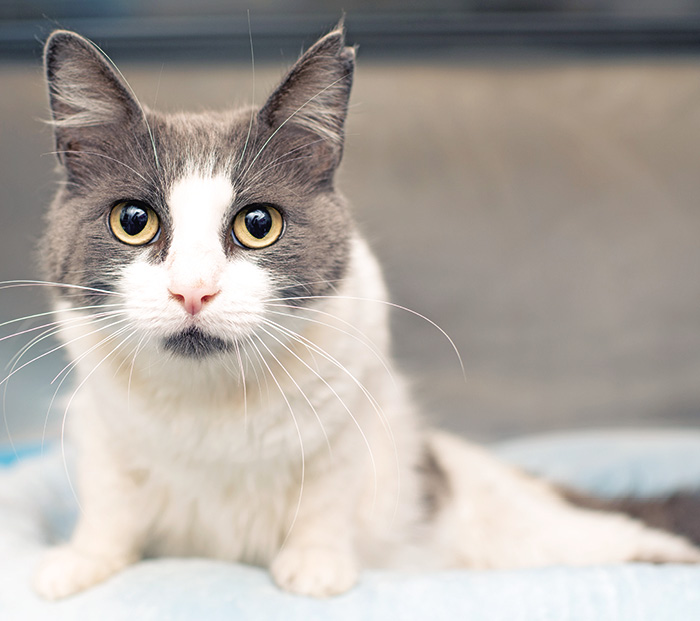Y
ou wake up to the sounds of your 10-year-old cat meowing loudly. When you find him, you are shocked to find he can’t move his rear legs and is having difficulty breathing. Sadly, your cat may have aortic thromboembolism (clot), often referred to as FATE (feline aortic thromboembolism). It is painful and frequently fatal. Treatment within six hours of onset is important for the best prognosis. Male cats are at a higher risk, and most cases occur in 8- to 12-year-old cats.
Aortic emboli almost always occur secondary to heart disease in cats, and the leading cause is hypertrophic cardiomyopathy, the most common heart disease in cats. Unfortunately, FATE is often the first sign of heart trouble, and it often comes on with no warning.
It’s a Clot
An aortic embolism is a thrombus, the medical term for a blood clot. In most cases, the clot forms in the left atrium of the heart due to stasis of blood and damage to the lining of this heart chamber. At some point, the clot, or parts of it, breaks loose and floats off in the bloodstream. If the clot ends up in a spot where it’s too big to advance any farther in the blood vessel, it gets stuck and blocks the flow of blood. In cats, this is often where the caudal aorta splits and runs down the hind legs. Just one side may be blocked, both sides may be blocked, or there can be partial blockages. Clots that form in the heart also may travel to other parts of the body, including the front limbs and brain, where they can obstruct blood flow.
The clot blocks motor function, resulting in paralysis, and most cats experiencing FATE are in severe pain. If you can gently pick your cat up, you may notice the leg(s) feel cool, especially the paws. Paws and nail beds may look bluish instead of a normal, healthy pink. If you check your cat’s temperature, his body temperature may be low. He may be breathing rapidly and shallowly.
While some cats will experience the effects in both legs, others have function in one leg, or minimal function in both if the blockage is not complete. One study found that one limb was affected in 20.8% of cats, two limbs in 77.6% of cats, and three or more limbs in 1.2% of cats.
Treatment
Cats with FATE must be treated by a veterinarian immediately. Thrombolytic medications to dissolve clots show little benefit, but one study showed that if anticoagulant medications (drugs that inhibit clotting) start within six hours of the acute problem, many cats recovered to normal or almost normal mobility. Aspirin and clopidogrel (Plavix) are the most commonly used anticoagulant drugs, and both must be dosed carefully. Other oral drugs, including the antithrombotics rivaroxaban and apixaban, show some promise in the treatment of FATE, and their efficacy is the subject of ongoing research.
At the vet clinic, your cat might receive injections of heparin. If your cat shows signs of heart failure, he may also be given diuretics and medications to manage arrhythmias and heart function. Supplemental oxygen can be helpful.
Pain medications are important to keep your cat comfortable, and once stabilized, your cat’s cardiac status will be evaluated so a treatment plan can be developed.
The desired goal is a slow, steady reperfusion of the affected tissues. Rapid perfusion can result in a large amount of toxic metabolic wastes being released all at once. Excess potassium in the blood can cause fatal heart arrhythmias, so your cat will need careful monitoring as he recovers.
Prognosis
If your cat can use his rear legs at all, his gait will be abnormal. He will stumble and have trouble staying upright. FATE is an emergency, and treatment within six hours of onset is considered important for the best prognosis.
While up to 50% of cats treated for FATE may survive to leave the hospital, the median survival time for cats that survive the first seven days after presentation is 93 days. Cases in which paralysis is more profound and/or lasts longer than 48 hours generally have a less favorable prognosis.
Recovery
Unfortunately, the recurrence of clotting is common. Keeping your cat on anticoagulants helps, but the underlying cardiac condition usually will slowly progress despite treatment. Many cats will be euthanized due to a poor prognosis.
If your cat has been diagnosed with hypertrophic cardiomyopathy, your veterinarian may prescribe a low dose of anticoagulants. You also may be referred to a veterinary cardiologist. Knowing your cat is at risk for FATE is ipmortant so that you can act upon any changes that may suggest FATE and seek veterinary help.




